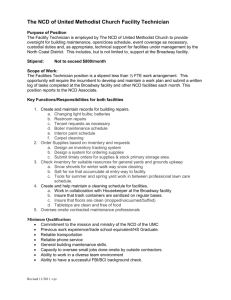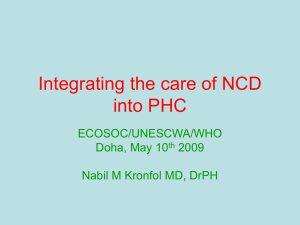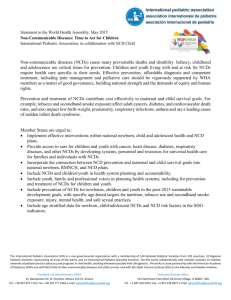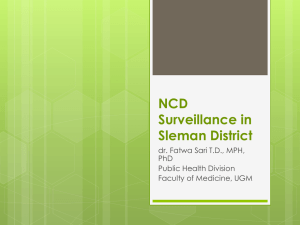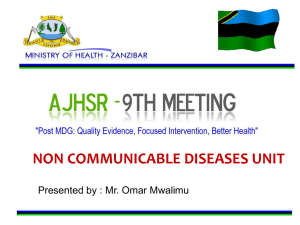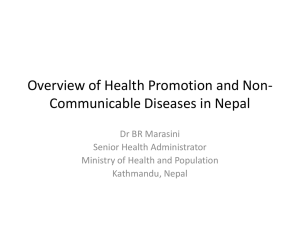BIO4503-NCD
advertisement
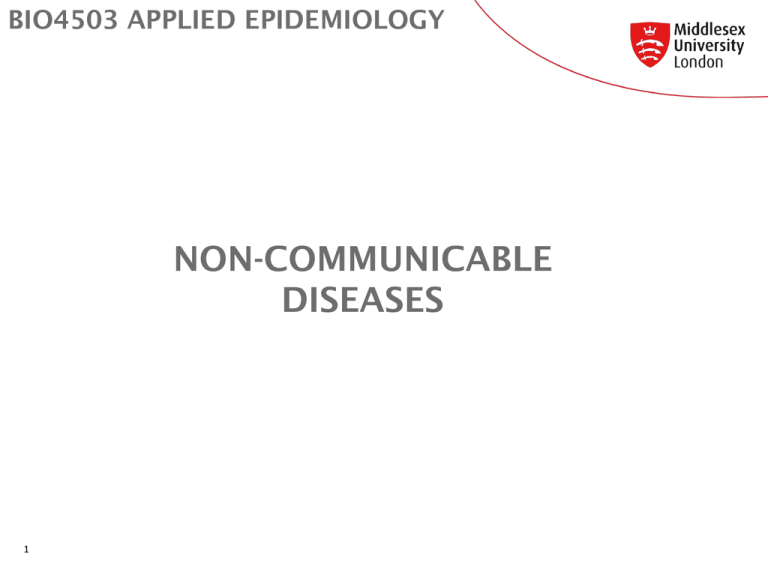
BIO4503 APPLIED EPIDEMIOLOGY NON-COMMUNICABLE DISEASES 1 DEFINITION AND RELATED CONCEPTS Def: “noncommunicable disease, (NCD) are no-transmissible between persons, medical conditions” Chronic vs, acute: NCDs may be chronic or acute Some examples: autoimmune diseases, heart disease, stroke, many cancers, asthma, diabetes, chronic kidney disease, osteoporosis, Alzheimer's disease, cataracts, and so on Risk factors: In opposition to infectious diseases, risk factors don’t include an infectious agent but are found in the person’s background: LIFESTYLE and ENVIRONMENT SOME MACRO-FIGURES AND FACTS • The rise of NCD started after the II WW. • Most prevalent leading causes of disease and mortality in developed countries • Increased burden in low- and middle- income countries • Already leading cause of death in developing countries!: • MORTALITY IN 2008: 57 million1 • NCD ASSOCIATED MORTALITY IN 2008: 36 million (2/3 of total) • Main NCDs mortality causes: • cardiovascular diseases, • cancers, • diabetes and 3 • chronic lung diseases WORLD 10 LEADING CAUSES OF MORTALITY. 2008 Deaths [millions] %of deaths Ischaemic heart disease 7.25 12.8% Stroke and other cerebrovascular disease 6.15 10.8% Lower respiratory infections 3.466 1% Chronic obstructive pulmonary disease 3.285 8% Diarrhoeal diseases 2.464 3% HIV/AID 1.78 3.1% Trachea, bronchus, lung cancers 1.392 4% Tuberculosis 1.342 4% Diabetes mellitus 1.262 2% Road traffic accidents 1.212 1% 4 NCD MORTALITY. 2011 5 CRITERIA FOR CAUSATION OF CHRONIC DISEASE. EVAN’S POSTULATES [I] 1. Prevalence of the disease should be significantly higher in those exposed to the hypothesized cause than in controls not so exposed. 2. Exposure to the hypothesized cause should be more frequent among those with the disease than in controls without the disease, when all other risk factors are held constant. 3. Incidence of the disease should be significantly higher in those exposed to the hypothesized cause than in controls not so exposed, as shown by the prospective studies. 4. The disease should follow exposure to the hypothesised causative agent with a normal or long-normal distribution of incubation periods. 5. A spectrum of host responses should follow exposure to the hypothesized agent along a logical biological gradient from mild to severe. 6 CRITERIA FOR CAUSATION OF CHRONIC DISEASE. EVAN’S POSTULATES [II] 6. A measurable host response following exposure to the hypothesized cause should have a high probability of appearing in those lacking this before exposure [e.g.: antibody, cancer cell] or should increase in magnitude if present before exposure. This response pattern should occur infrequently in persons not so exposed. 7. Experimental reproduction of the disease should occur more frequently in animals or humans appropriately exposed to the hypothesized cause then in those not so exposed: this exposure may be deliberate in volunteers, experimentally induced in the laboratory, or may represent a regulation of the natural exposure. 8. Elimination or modification of the hypothesized cause should decrease the incidence of the disease [e.g.: attenuation of a virus, removal of tar from cigarettes]. 7 CRITERIA FOR CAUSATION OF CHRONIC DISEASE. EVAN’S POSTULATES [III] 9. Prevention or modification of the host’s response on exposure to the hypothesized cause should decrease or eliminate the disease [e.g.: immunization, drugs to lower cholesterol, specific lymphocyte transfer factor in cancer] 10. All the relationships and findings should make biological and epidemiological sense. Source: Evans, AS. (1976). Causation and disease. The Henle-Koch postulated revisited. Yale Journal of Biology and Medicine. 49:175-195 8 NCD and globalisation • NCDs are caused, to a large extent, by four behavioural risk factors that are pervasive aspects of economic transition, rapid urbanization and 21st-century lifestyles: 1. tobacco use, 2. unhealthy diet, 3. insufficient physical activity 4. harmful use of alcohol. Current population-wide initiatives fall short in the global context. E.g.: <10% of the world’s population is fully protected by any of the tobacco demand-reduction measures contained in the WHO Framework Convention on Tobacco Control 9 MACRO ANALYSIS OF THE FOUR BEHAVIOURAL RISK FACTORS FOR NCD: TOBACCO • Almost 6 million people die from tobacco use each year, both from direct tobacco use and second-hand smoke. • By 2020, this number will increase to 7.5 million, accounting for 10% of all deaths. • Smoking is estimated to cause about 71% of lung cancer, 42% of chronic respiratory disease and nearly 10% of cardiovascular disease. • The highest incidence of smoking among men is in lower-middle-income countries • For total population, smoking prevalence is highest among upper-middle-income countries 10 MACRO ANALYSIS OF THE FOUR BEHAVIOURAL RISK FACTORS FOR NCD: INSUFFICIENT PHYSICAL ACTIVITY • Approx. 3.2 million people die each year due to physical inactivity. • People who are insufficiently physically active have a 20% to 30% increased risk of all-cause mortality. • Regular physical activity reduces the risk of cardiovascular disease including high blood pressure, diabetes, breast and colon cancer, and depression. • Insufficient physical activity is highest in high-income countries, but very high levels are now also seen in some middle-income countries especially among women. 11 MACRO ANALYSIS OF THE FOUR BEHAVIOURAL RISK FACTORS FOR NCD: HARMFUL USE OF ALCOHOL • Approx. 2.3 million die each year from the harmful use of alcohol, accounting for about 3.8% of all deaths in the world. • More than half of these deaths occur from NCDs including cancers, cardiovascular disease and liver cirrhosis. • While adult per capita consumption is highest in high-income countries, it is nearly as high in upper-middle-income countries. 12 MACRO ANALYSIS OF THE FOUR BEHAVIOURAL RISK FACTORS FOR NCD: UNHEALTHY DIET • Adequate consumption of fruit and vegetables reduces the risk for cardiovascular diseases, stomach cancer and colorectal cancer. • Most populations consume much higher levels of salt than recommended by WHO for disease prevention; high salt consumption is an important determinant of high blood pressure and cardiovascular risk. • High consumption of saturated fats and trans-fatty acids is linked to heart disease. • Unhealthy diet is rising quickly in lower-resource settings. Available data suggest that fat intake has been rising rapidly in lower-middle-income countries since the 1980s. 13 • Let’s see some testimonials http://www.youtube.com/watch?v=4nHMV_420 zg 14 MONITORING AND SURVEILLANCE OF NCDs Four main types of indicators: Exposures • 1. Behavioural risk factors • 2. Physiological and metabolic risk factors Outcomes • 3. Mortality • 4. Morbidity 15 1. BEHAVIOURAL FACTORS • Prevalence of current daily tobacco smoking among adults. • Prevalence of insufficiently active adults defined as: – <5 times*30 minutes of moderate activity per week, or – <3 times*20 minutes of vigorous activity per week, – or equivalent. • Prevalence of adult population consuming >5 grs. of dietary sodium chloride per day. • Prevalence of population consuming <5 total servings (400 grams) of fruit and vegetables per day. • Adult per capita consumption in litres of pure alcohol (recorded and unrecorded) 16 2. PSYCHOLOGICAL AND METABOLIC FACTORS • Prevalence of raised blood glucose among adults (fasting plasma glucose value ≥ 7.0 mmol/L (126 mg/dl) or on medication for raised blood glucose). • Prevalence of raised blood pressure among adults (systolic blood pressure ≥ 140 mmHg and/or diastolic blood pressure ≥90 mmHg or on medication for raised blood pressure. • Prevalence of overweight and obesity in adults and adolescents (BMI > than 25 kg/m2 for overweight or 30kg/m2 for obesity or for adolescents according to the WHO Growth Reference). • Prevalence of low weight at birth (< 2.5 kg). • Prevalence of raised total cholesterol among adults (total 17 cholesterol ≥ 5.0 mmol/l or 190mg/dl). 3 MORTALITY and 4. MORBIDITY • All-cause mortality by age, sex and region (urban and rural, or by other administrative areas, as available). • Cause-specific mortality data (urban and rural, or other administrative areas, as available). • Unconditional probability of death between ages 30 and 70 years from cardiovascular diseases, cancer, diabetes, and chronic respiratory diseases. • Cancer incidence data from cancer registries, by type of cancer. 18 GLOBAL HEALTH STRATEGY • Major global political statement on NDC: “Global strategy for the prevention and control of non communicable diseases” • Endorsed by the WHA (2000). • Three main objectives: 1. Mapping the epidemic of NCDs and their causes 2. Reducing the main risk factors through health promotion and primary prevention approaches 3. Strengthening health care for people already afflicted with NCDs. 19 ACTION PLAN FOR THE GLOBAL HEALTH STRATEGY. SIX OBJECTIVES1 1. To raise the priority accorded to NCD in development work at global and national levels, and to integrate prevention and control of NCDs into policies across all government departments. 2. To establish and strengthen national policies and plans for the prevention and control of NCD 3. To promote interventions to reduce the main shared modifiable risk factors for NCD: tobacco use, unhealthy diets, physical inactivity and harmful use of alcohol 4. To promote research for the prevention and control of NCD 5. To promote partnerships for the prevention and control of NCD 6. To monitor NCD and their determinants and evaluate progress at the national, regional and global levels 20 FRAMINGHAN HEART STUDY Longitudinal study aiming to better understand the epidemiology of CVD. Started in 1948 [original cohort had not yet developed symptoms of CVD] and the on going follow up is in already its 6th cohort. SOME MILESTONES: • 1960: Cigarette smoking found to increase the risk of heart disease • 1967: Physical activity found to reduce the risk of heart disease and obesity to increase the risk of heart disease • 1970: High blood pressure found to increase the risk of stroke • 1978: Psychosocial factors found to affect heart disease • 2002: Lifetime risk of developing high blood pressure in middle-aged adults is 9 in 10. • 2002: Obesity is a risk factor for heart failure. • 2010: First definitive evidence that occurrence of stroke by age 65 years in 21 a parent increased risk of stroke in offspring by 3-fold RECOMMENDED READING • WHA 2000. “Global strategy for the prevention and control of NCD. Report by the Director-General: A challenge and an opportunity”. WHA 53rd session. • WHO (2008) “2008-2013 Action Plan for the Global Strategy for the Prevention and Control of NCD”. • WHO (2013) “World health statistics 2012” • WHO (2013) “Non communicable diseases. Country profiles 2011” • WHO (2003) “WHO Framework Convention on Tobacco Control” • WHO “WHO Global Strategy on Diet, Physical Activity and Health” 2004 22 RECOMMENDED READING [cont] • Beaglehole R and Yach D (2003) Globalisation and the prevention and control of non-communicable disease: the neglected chronic diseases of adults. The Lancet, Volume 362, Issue 9387, 13 September 2003, p 903-908 • Banerjee A. Tracking global funding for the prevention and control of noncommunicable diseases. Bull World Health Organ. At: 2012;90:479–479. http://www.who.int/bulletin/volumes/90/7/12-108795/en/ • Alleyne G. (2011) Who’s Afraid of Noncommunicable Diseases? Raising Awareness of the Effects of Noncommunicable Diseases on Global Health. Journal of 23 Health Communication, 16:82–93, 2011
